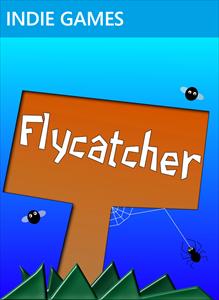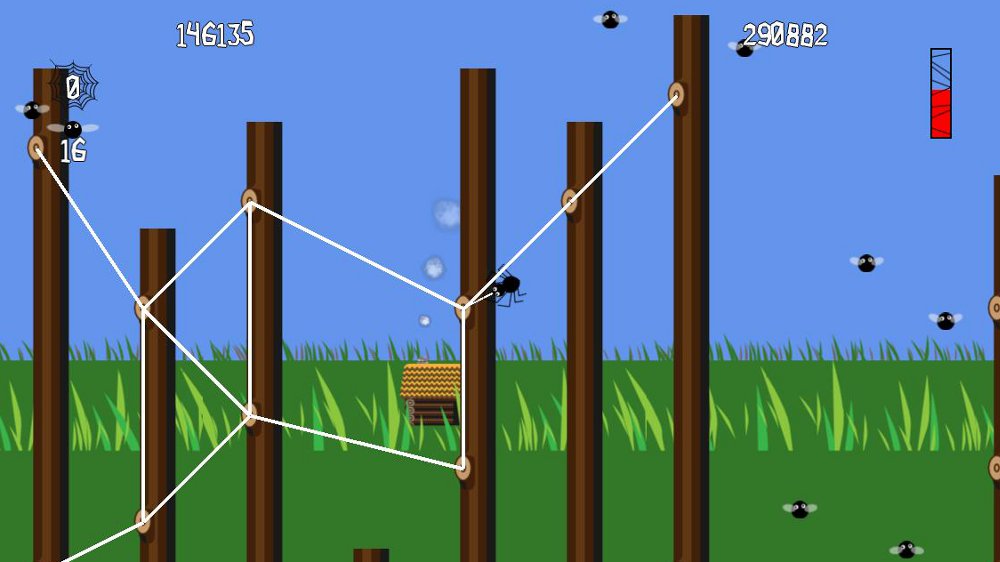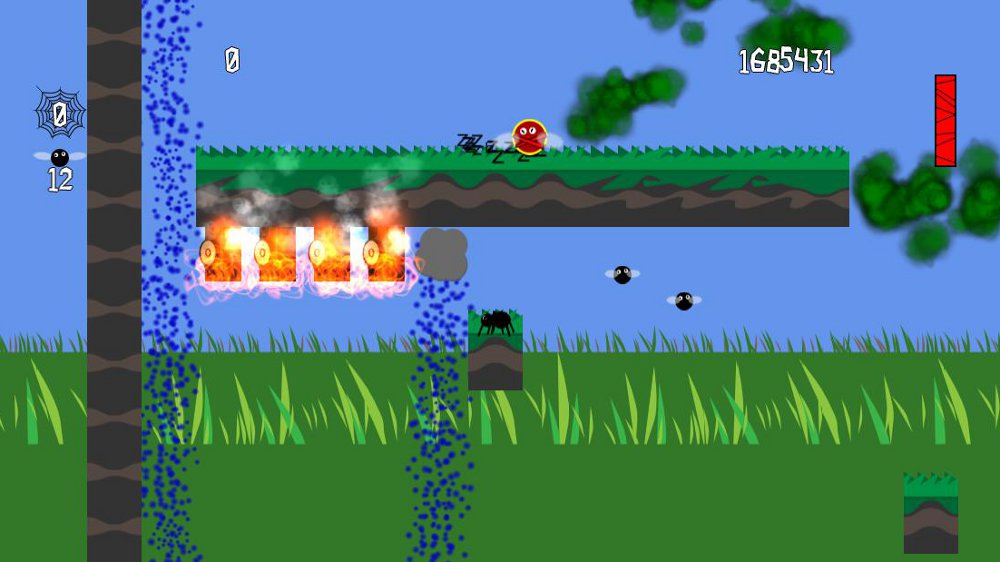Flycatcher doesn’t leave the best first impression at a glance. Its title is hardly inspiring; while it certainly represents the core principle of the game, a title that sounds like budget domestic insect repellant doesn’t do an indie game any favors. Things aren’t quite that simple, though. Flycatcher is like a respectable city gent who dresses himself in the rags of a substance-addled vagrant for reasons best known to himself – its true strengths are hidden behind its offputtingly unhygienic exterior.
There’s no way to be circumspect about this and still get the point across adequately: Flycatcher looks bad. It also sounds bad, and quite possibly smells bad. I imagine if you were to lick it, it would also taste pretty nasty. It is a sensory tour de fiasco. Still, there’s wisdom in the old saying “don’t judge a book by its cover”, and Flycatcher embodies it.
The premise is simple. You are a spider, named Flycatcher by your unsettlingly literal-minded spider parents, and your job is to eliminate all the flies, wasps and beetles that are plaguing your fellow creatures. You can do this by either shooting them directly with a strand of web, or by snagging them with a strand that you’re swinging on. Later you can also spin enduring webs between trees, though I never found this particularly effective.
Catching bugs is the motivation, and meeting the required minimum to exit each level is the core principle, but it’s not really what the game is about. In practice, it’s about swinging exhileratingly around obstacle-filled levels, trying not to fall into water or set yourself on fire. Focusing on this aspect of the gameplay was a good choice, as this is where most of the fun comes from. Using this unusual form of movement effectively is both essential for completion of the levels, and surprisingly satisfying as you begin to devise and master more complex maneuvers. Oddly enough, I ended up feeling like Spider-Man.
It’s a simple thing, but I must emphasize how much the experience of swinging around obstacles, changing direction mid-flight and catching that elusive bug improved my opinion of Flycatcher. With a less carefully crafted swinging mechanic, like the infuriating Grapple Boy, the game would have foundered. Maybe it’s just me, but nimbly swooping around kept a smile on face.
There are also some nice little touches that add to the experience. Your spider has two additional powers; increased swing momentum is by far the more useful, enabling you to launch yourself further than usual, but even the largely redundant ability to slow time is a welcome option.
The swinging mechanic that provides the fun also provides the frustration. Aiming your web shots with the right analogue stick is an imprecise art, which can make it tricky to hit a knot hole or small ledge mid-flight. Worse, the web’s range is limited but its limit is beyond the edge of your view, so it can be hard to know whether you’re shooting anywhere near your intended target. You can zoom out to a more distant view by holding the left bumper but, like recent platformer A Voxel Action, Flycatcher has whole levels where this is constantly useful, forcing you to navigate tricky obstacles with your finger clamped to the shoulder. Good luck finding that comfortable. Why so many developers choose not to implement a toggle, I don’t know.
The nature of the web itself adds some additional inconvenience. It adheres anew to any surface it touches while you’re swinging, and while this is sometimes useful, it also means that when you’re swinging back and forth in one place you creep noticeably along the ledge as the top part of the strand brushes against it and sticks to a new point every couple of seconds. This sounds minor, but it can really mess up some maneuvers that would otherwise have worked out.
It’s not an insurmountable oddity, though. For the most part, the swinging mechanic works well. The game also benefits from some good design choices. The introduction of new mechanics – web-resistant beetles, waterfalls, knot holes, and more – is paced very well, and they all affect gameplay in ways that are distinct and well thought out. It’s clear that the developers took some care in designing and balancing their game, and for that I commend them.
On balance, Flycatcher provides some fun but I’m not sure I can go as far as to recommend it. I’m not someone who demands slick presentation in order to enjoy a game. I still play Pirates! on the NES, and that’s one of the ugliest things ever created by man or beast. Flycatcher‘s presentation issues do let down though, making it feel cheaper and more amateurish than it should. Its ideas and design, while not dazzlingly original, are fresh enough and thoughtful enough to deserve better clothing. I also feel that the game might work better as an iOS or Android release. I think it would come into its own with touch controls, and being played in short sessions of one or two levels on the bus to work.
Flycatcher, then, isn’t a bad purchase. I don’t think you’d kick yourself for shelling out a mere 80 Microsoft points to own it, unless you don’t like this type of game or you insist on pretty visuals. But would you sit down at your Xbox for a couple of hours and finish it? I’m not convinced. With better presentation, some refinement of the mechanics and a release on a mobile platform, Flycatcher could be worth picking up to play on the go.
As it is, it’s worth playing the trial to see if you enjoy swinging around the levels. I know I genuinely had fun with it for an hour or two, and that’s what matters. If that doesn’t do it for you, though, then Flycatcher won’t hold your attention.
Overall Rating: 




© 2012 – 2013, The Indie Mine. All rights reserved.








Trackbacks/Pingbacks
[...] wrote this review for The Indie Mine, using a review copy they provided. Please take a look. Reproduced here with [...]